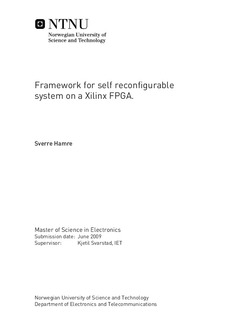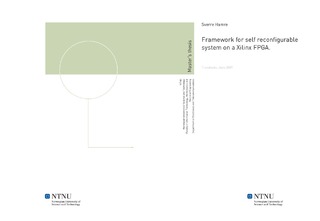| dc.description.abstract | Partial self reconfigurable hardware has not yet become main stream, even though the technology is available. Currently FPGA manufacturer like Xilinx has FPGA devices that can do partial self reconfiguration. These and earlier FPGA devices were used mostly for prototyping and testing of designs, before producing ASICS, since FPGA devices was to expensive to be used in final production designs. Now as prices for these devices are coming down, it is more and more normal to see them in consumer devices. Like routers and switches where protocols can change fast. Using a FPGA in these devices, the manufacturer has the possibility to update the device if there are protocol updates or bugs in the design. But currently this reconfiguration is of the complete design not just modules when they are needed. The main problem why partial self reconfiguration is not used currently, is the lack of tools, to simplify the design and usage of such a system. In this thesis different aspects of partial self reconfiguration will be evaluated. Current research status are evaluated and a proof of concept incorporating most of this research are created. Trying to establish a framework for partial self reconfiguration on a FPGA. In the work the Suzaku-V platform is used, this platform utilizes a Virtex-II or Virtex-IV FPGA from Xilinx. To be able to partially reconfigure these FPGA's the configuration logic and configuration bitstream has been researched. By understanding the bitstream a program has been developed that can read out or insert modules in a bitstream. The partial reconfiguration in the proof of concept is controlled by a CPU on the FPGA running Linux. By running Linux on the CPU simplifies many aspects of development, since many programs and communication methods are readily available in Linux. Partial self reconfiguration on a FPGA with a hard core powerPC running Linux is a complicated task to solve. Many problems were encounter working with the task, hopefully were many of these issues addressed and answered, simplifying further work. Since this is only the beginning, showing that it is possible and how it can be done, but more research must be done to further simplify and enhance the framework. | nb_NO |

